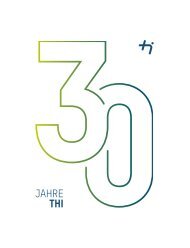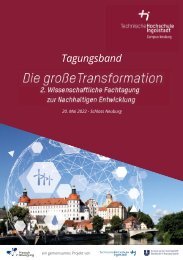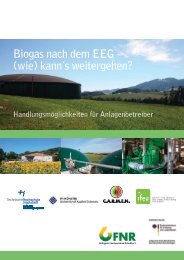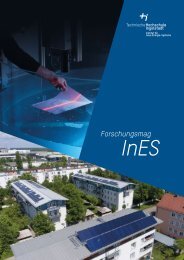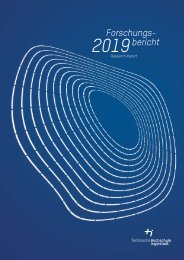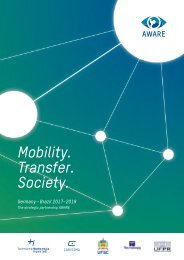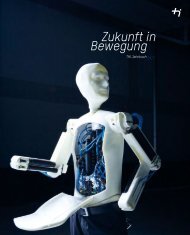THimotion Nr. 1
Sie wollen auch ein ePaper? Erhöhen Sie die Reichweite Ihrer Titel.
YUMPU macht aus Druck-PDFs automatisch weboptimierte ePaper, die Google liebt.
Selected Articles in English<br />
This new course of study will be offered<br />
by the Faculty of Electrical Engineering<br />
and Computer Sciences at the Technische<br />
Hochschule Ingolstadt beginning<br />
the winter semester 2014/15. It will<br />
train graduates in special know-how in<br />
the fields of design and development<br />
of innovative computer user interfaces.<br />
The UXD bachelor’s programme provides<br />
interdisciplinary knowledge from the<br />
fields of informatics, design, psychology,<br />
business administration as well as<br />
communication and social sciences. The<br />
seven semesters of the course include<br />
one internship semester during which<br />
students gain practical experience in<br />
industry, engineering offices or design<br />
agencies.<br />
The Technische Hochschule Ingolstadt<br />
also expects the UXD courses<br />
to attract a high percentage of female<br />
students as well. A survey carried out<br />
among pupils in Ingolstadt schools<br />
revealed that around 30 percent of those<br />
interested in the programme were female.<br />
The programme will be open to a total of<br />
50 students, and so far, there is no comparable<br />
course of study being offered at<br />
any regional or national university.<br />
A master‘s degree for future-oriented<br />
thinkers P. 18<br />
Traffic chaos in mega-cities; air<br />
pollution from vehicle exhaust: automobile<br />
manufacturers are under increasing<br />
pressure to develop new innovations<br />
in the field of electric mobility.<br />
The subject of mobility presents<br />
enormous challenges to every society.<br />
The Technische Hochschule Ingolstadt<br />
is therefore introducing its new master’s<br />
programme „Automotive & Mobility<br />
Management“ (AMM) in an attempt to<br />
address these challenges. The course of<br />
study, which will begin in the 2014/15<br />
winter semester, focuses on the field of<br />
mobility-related business development.<br />
It will teach skills required to develop<br />
and implement innovative mobility concepts.<br />
The automotive segment and<br />
ancillary fields such as e-mobility and<br />
traffic communication will play important<br />
roles in the AMM curriculum.<br />
With the introduction of the interdisciplinary<br />
AMM Master’s programme, the<br />
Technische Hochschule Ingolstadt is<br />
sharpening its international profile once<br />
again. The subject of mobility continues<br />
to grow at the THI with special emphasis<br />
on the related fields of management,<br />
IT and engineering. The great interest in<br />
the Technische Hochschule shown by<br />
a number of automotive and aerospace<br />
companies underlines the cutting-edge<br />
character of the new master’s programme,<br />
the concept for which was prepared<br />
in close cooperation with representatives<br />
from the automotive industry and<br />
their suppliers. 25 students per year can<br />
enrol in the programme. The course will<br />
begin in both the winter and summer semesters.<br />
60<br />
CARISSMA – research for more<br />
traffic safety P. 22<br />
In summer 2010, the German Council<br />
of Science and Humanities (Wissenschaftsrat)<br />
approved CARISSMA and<br />
thus the building of a research facility<br />
absolutely unique among Germany’s<br />
universities of applied sciences. The<br />
future „Center of Automotive Research<br />
on Integrated Safety Systems and Measurement<br />
Area“ – or CARISSMA for<br />
short – is certainly a milestone in the<br />
future development of applied research<br />
at the Technische Hochschule Ingolstadt<br />
and for research into traffic safety<br />
in Germany as well.<br />
The research building, which is to be<br />
built parallel to the ongoing expansion<br />
of the university campus on the neighbouring<br />
foundry grounds, will cost a<br />
total of 28 million euros. The groundbreaking<br />
ceremony for the CARISSMA<br />
building will take place on the 2nd April<br />
in the presence of the Bavarian Premier,<br />
Horst Seehofer, the minister of state,<br />
Dr. Ludwig Spaenle, and other wellknown<br />
politicians, business managers<br />
and academics.<br />
The CARISSMA team, made up of<br />
13 professors and their research assistants,<br />
submitted applications for the<br />
nine large-scale testing units, which<br />
will be at the heart of CARISSMA, to<br />
the German Research Society (Deutsche<br />
Forschungsgemeinschaft – DFG)<br />
at the end of 2013. The philosophy of<br />
the interdisciplinary networking of the<br />
large-scale units, which will cost around<br />
six million euros, reflects the basic<br />
CARISSMA principles. They are to enable<br />
virtual and real tests as well as backup<br />
tests to be carried out for passive,<br />
active and integral vehicle safety.<br />
CARISSMA takes an interdisciplinary<br />
approach. It covers various sub-disciplines<br />
from the field of engineering (e.g.<br />
vehicle mechatronics, electrical engineering,<br />
mechanical engineering, informatics)<br />
and intends to combine these<br />
in future with other academic disciplines<br />
including traffic psychology, traffic<br />
education and traffic economics, for<br />
example. The ultimate goal, of course,<br />
is to make a significant contribution to<br />
the „Vision Zero“ campaign: the vision<br />
of zero road deaths. The technical aim,<br />
therefore, is the implementation of a<br />
„global safety system“ based on the the<br />
bionic principle to simulate the human<br />
senses of feeling, hearing, seeing and<br />
communicating.<br />
These days, an important aspect of<br />
the development of passive safety is the<br />
networking of systems designed for active<br />
vehicle safety and driver assistance.<br />
In the future, for example, new vehicle<br />
sensors will be available that can increase<br />
the performance of crash detection<br />
devices. One example is the current research<br />
project „Innovative Crashsensing<br />
Architectures – InCar“ which is being<br />
carried out in cooperation with Audi AG<br />
and is focussing on predictive sensors<br />
and systems for the actuation of passenger<br />
protection systems.<br />
The „HiPe-FiS“ project examines new<br />
actuation concepts for active and passive<br />
systems (e.g. airbags). The project<br />
intends to close the current gap between<br />
accidents in the real world and the<br />
standardised conditions in crash laboratories.<br />
These aspects are especially interesting<br />
when applied to emerging<br />
countries. According to figures from the<br />
WHO, 90 percent of road accidents<br />
occur in countries with low or medium<br />
income levels. The weakest road users<br />
– children and teenagers – are particularly<br />
affected. CARISSMA hopes to network<br />
its research programme and make<br />
an important contribution to the sociopolitical<br />
and technological realisation of<br />
Vision Zero.<br />
In this context, the strategic partnership<br />
with Brazil through the AWARE<br />
project offers an important (scientific)<br />
exchange platform. In this specific emer-



